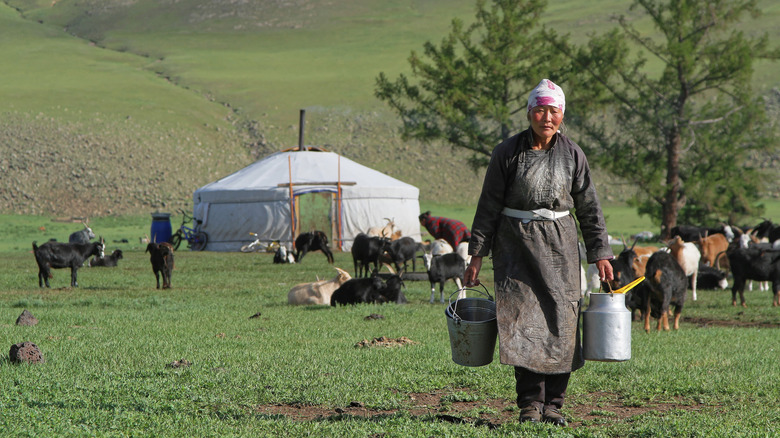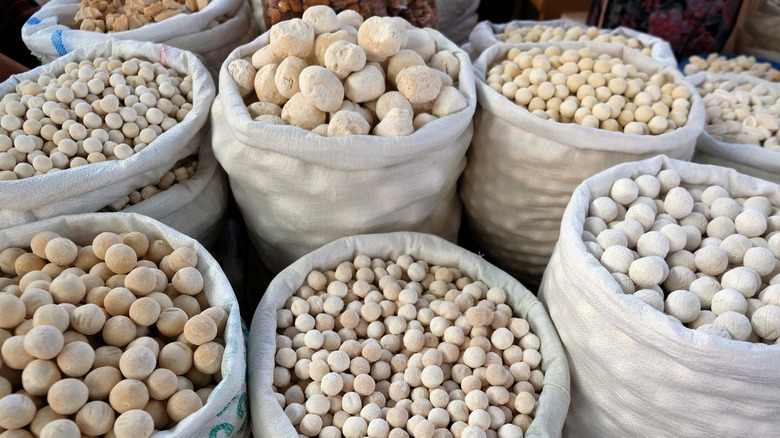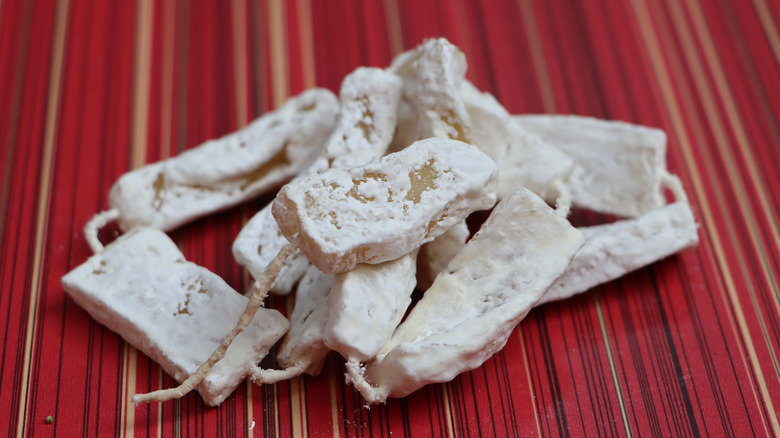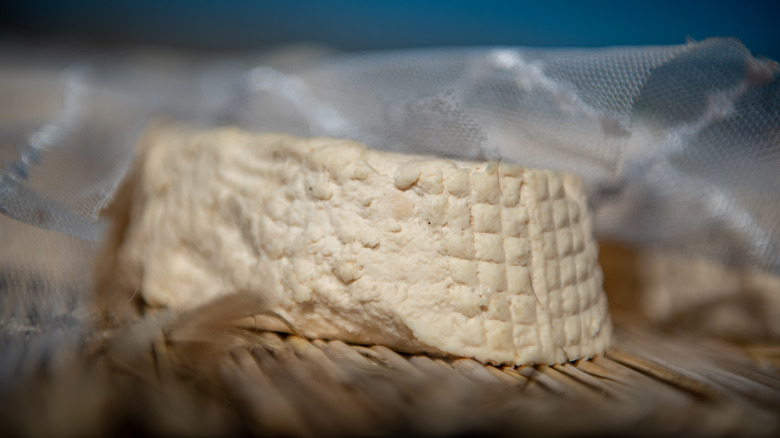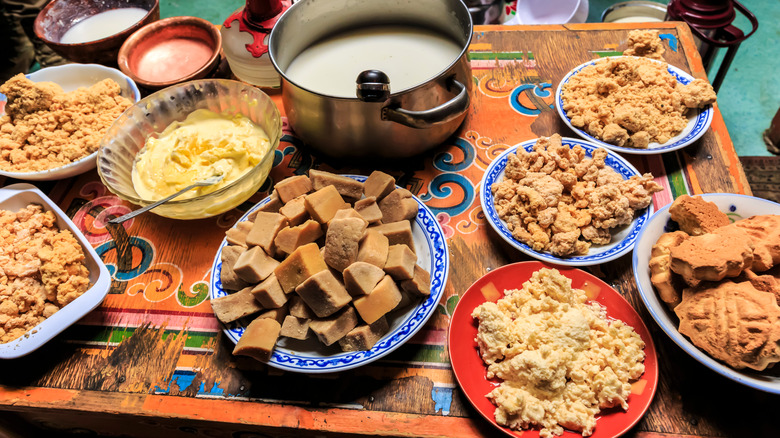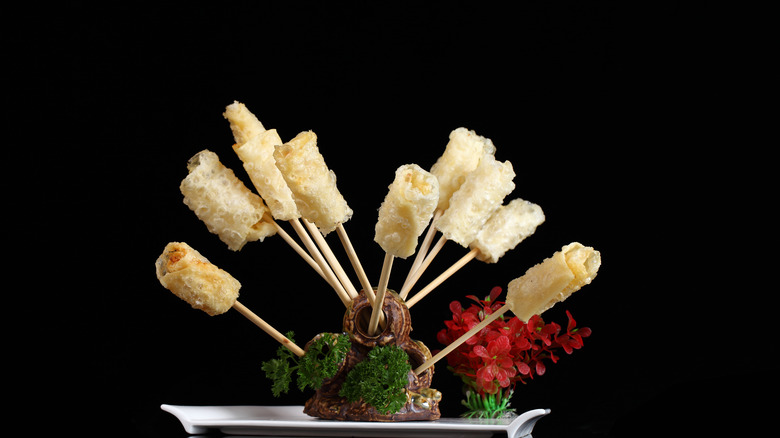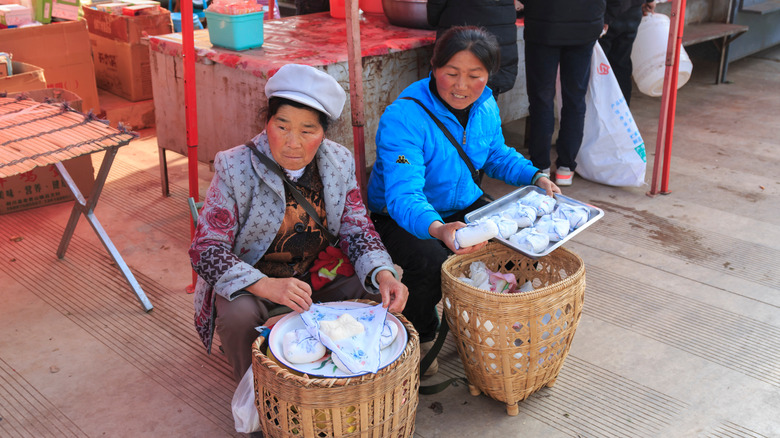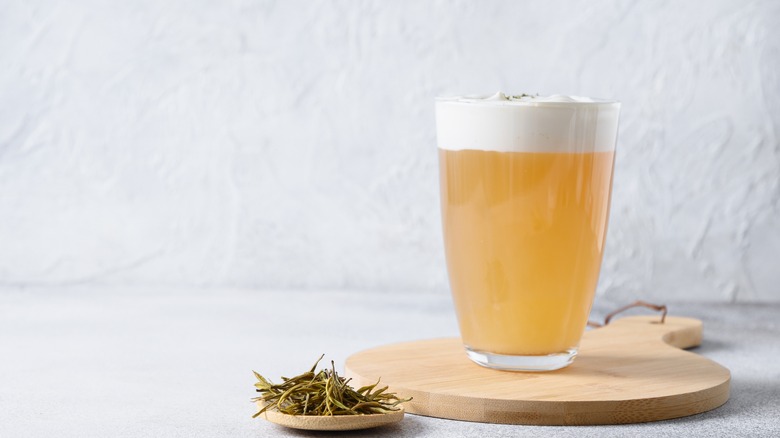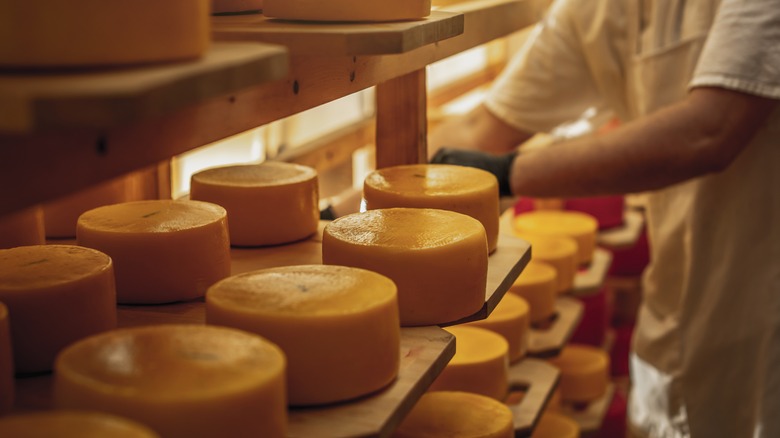10 Types Of Cheeses In China, Explained
When you think of Chinese food, cheese probably isn't the first thing that comes to mind. Tofu, produced for thousands of years, is often nicknamed "Chinese cheese," and in a traditional Chinese diet, provides some of the same nutrients, like calcium, that in other cuisines would be provided by dairy. An article by Hilary A. Smith in "Moral Foods" describes how early Western anthropologists from dairy-centric cultures were puzzled over what they perceived as China's "lactophobia" (fear of milk). And while dairy has never played a major role in the food of the Han people, China's primary ethnic group (Han people make up 91% of China's population), some of China's 50+ ethnic minorities have long traditions of herding dairy-producing animals and making various types of cheese from their milk.
There are also lesser-known regional cheeses produced by Han communities in China, not to mention the ever-growing market for Western cheeses and other dairy products, some of which are now being produced in China for the first time. Far from being lactophobic, Chinese consumers are embracing dairy more and more each year: Just Food reports that the Chinese cheese market passed $1 billion USD in value in 2021 and is predicted to exceed $1.6 billion by 2026. As tastes and cuisines change, there may well come a time when we do think of cheese alongside the thought of Chinese food. Until then, here are the most notable and unique cheeses in China's culinary landscape.
Kurut
For nomadic herders on the plains of ancient Central Asia, dairy was a precious nutritional resource that had to be carefully preserved. When these nomads arrived in western China, they brought with them China's earliest-known cheese. Dried cheese curd balls have been found in a tomb in western China dating to 4,000 years ago, placed on the chest of a female mummy known as the Beauty of Xiaohe, per reporting by Atlas Obscura.
In China's western province of Xinjiang, the Uyghur (or Uighur) ethnic minority still produces a cheese called kurut that is essentially identical to this ancient cheese. Milk is allowed to sour naturally, and the solid curds are strained out, rolled into balls, and air-dried until very hard. The resulting product has a tangy, Parmesan-like funkiness and can be chewed or used as a cooking ingredient when grated or dissolved in boiling water. Central Asian Turkic peoples like Uzbeks and Kazakhs, culturally related to the Uyghurs, also produce kurut under similar names in places such as Kyrgyzstan. In West Asian countries like Iran and Turkey, kurut is known as kashk. Instead of milk, kurut or kashk may be made using yogurt or the liquid byproducts of cheesemaking (whey) or butter making (buttermilk), which some would argue makes it not technically considered a cheese.
Chhurpi
Tibetans are another ethnic minority in China with a long history of herding and dairying. Tibetan cheeses are characterized by strong grassy flavors and are usually made from the buttermilk or milk of dri (female yaks) or chauri (cow/yak hybrids, which produce more milk than purebred yaks). Tibetan cheeses may be prepared fresh (un-aged) but are often dried for ease of transport and preservation.
Chugum or chura is among the most common of these dried cheeses, tiny hard kernels of curd that can be strung like beads for easy snacking during long yak drives through the Himalayas. Another notable Tibetan cheese is chhurpi, said to be the hardest cheese in the world. After being dried and smoked, chhurpi is aged in the open air for six months to a year. This process grants chhurpi an incredibly long shelf life of up to twenty years, making it an invaluable long-term store of nutrition.
Cheese is widely used in Tibetan cuisine. Fresh, undried chhurpi can be cooked in curries and soups or pickled with cucumber and radish. Once dried, hard Tibetan cheese can be softened in hot soup or tea or grated into a variety of dishes, both savory and sweet, often combined with the Tibetan staple of tsampa (roasted barley flour).
Byaslag
The Chinese province of Inner Mongolia (which borders the sovereign nation of Mongolia) is home to most of China's ethnic Mongols. Various market reports suggest that Inner Mongolia was the center of Chinese cheese production until only a few decades ago, with traditional cheese products often produced for sale to Chinese tourists.
As nomadic herders of "the Five Snouts" (cows/yaks, horses, sheep, goats, and camels), the Mongols are a people who traditionally subsisted on dairy. Mongol cheesemakers do not use salt and add kefir (sour yogurt) to milk as a coagulant rather than rennet or acid, though they may simply allow the milk to sour on its own. Like Tibetan cheeses, Mongol cheeses may be consumed fresh or air-dried in slices but are not aged like European cheeses.
Of the three broad categories of Mongolian cheese, byaslag is the one that shows the least regional variation. It's a firm, un-aged cheese with a mild flavor, generally made from cow's milk and comparable to mozzarella when fresh or Edam or Gouda when dried. A typical way to eat byaslag would be to slice it into the same bowl that contains savory milk tea (seasoned with salt, not sugar), boortsog (fried dough), or bansh (small dumplings). Because fresh byaslag doesn't have a long shelf life, it's not as widely known as the other two categories of Mongol cheese, which are dried: aaruul and eezgii.
Eezgii
In the 13th century, Marco Polo made note of how the Mongol Empire's soldiers carried powdered milk for sustenance, demonstrating the expertise of Medieval Mongols in preserving dairy products. Later, in a book titled, 'The History of Fermented Tofu", William Shurtleff theorizes Mongol cheesemaking as the origin of Han tofu-making. A common cooking ingredient called furu, meaning "molded milk" in Chinese, originally used to refer to Mongol dairy cheese but later became the term for the cheese-like texture of fermented tofu.
In Mongolian, the hard, air-dried curds of various kinds of milk, similar in many respects to Central Asian kurut, are known as aaruul. These are prepared in various shapes, colors, and sizes that vary between regions and communities. But aaruul and byaslag are not the only ways of preserving curds. Another Mongol method is to toast the curds in a pan over a fire until dry and lightly caramelized, creating a cheese known as eezgii.
Eezgii has a crumbly appearance and a dark color and is primarily a snacking cheese like the hard-dried chura of Tibet. Its taste can be described as lightly sweet, and its texture as grainy or floury. Some cheese experts have mapped the path of eezgii to other nomad groups, which have borrowed the name and preparation of the cheese from the Mongols. The Manchu of northeastern China and the Baraba Tatars of Siberia are two such ethnicities, though deviations between cultural taste and usage of eezgii are sure to occur along the way.
Rǔshān
Of the 56 officially-recognized ethnic groups in China, 25 of them (including a large number of Tibetans) call Yunnan province home, making this province one of the most diverse in China. Many people here had little contact with other parts of China until the 1950s, meaning that much of their traditional culture has been preserved. Given Yunnan's incredible human diversity, it's no surprise that the region is home to many unique foods, including several kinds of cheese.
Rǔshān, meaning "milk fan" in Mandarin, is a specialty of northwestern Yunnan. The Chinese name comes from this cheese's resemblance to a folding fan. Cow's milk is coagulated using acidic quince juice or soured buttermilk, and the heated curds are gently stretched into thin sheets and wrapped around bamboo poles to dry. These leathery, cheesy-tasting curds are then fried and sprinkled with sugar or grilled and rolled on a stick as street food, sometimes with sweet toppings like condensed milk and fruit or rose jam (edible flowers being another culinary specialty of Yunnan).
Exactly how long rǔshān has been produced is unknown, but a similar type of cheese was referenced in 1641, according to "Mozzarella of the East," a report on Bai cheese traditions. However, cheese experts disagree on whether Bai, Tibetan, and Mongol cheesemaking traditions have influenced one another and in what direction that influence has run.
Rǔbǐng
Another regional Chinese food of Yunnan, rǔbǐng, like its cousin rǔshān, is made by the Bai people, as well as some other ethnic minorities such as the Yi. The name rǔbǐng means "milk pancake" in reference to the thin, flat slices the cheese is often served in. Rǔbǐng may be made from either goat, sheep, or cow's milk, with goat and sheep being more typical, coagulated using an acidic solution derived from a cultivated vine and pressed of its moisture. Among the Sani branch of the Yi people, rǔbǐng cheese is known as "sheep tofu," a recognition of the similar procedures used in cheese and tofu production.
A fresh cheese, rǔbǐng's firm texture makes it comparable to paneer or halloumi, and it does not melt easily. Unlike rǔshān, which is typically served sweet, rǔbǐng is most often found in savory dishes. It can be fried until golden or stir-fried in small pieces, similar to some Tibetan cheeses (or tofu). One classic preparation is rǔbǐng stir-fried with fava beans; in another, slices of the cheese are steamed with slices of Yunnanese cured ham.
Nguri (Niúrǔ)
Ethnic minorities in remote rural communities are not the only people in China with a history of cheesemaking. Cheese is referenced in Medieval Chinese literature, and there was once a thriving cheese industry around the city of Shanghai, with surviving 16th-century recipes for dishes such as cheese-filled dumplings. Further south, in parts of the provinces of Guangdong and Fujian, locals have been producing a type of cheese since at least the Ming Dynasty (14th to 17th centuries). Known as nguri or, in standard Mandarin, niúrǔ, literally meaning "cow's milk," it's actually made from the rich, fatty milk of water buffalo, not unlike Italian buffalo mozzarella (though there is no evidence of a direct connection).
As Veronica Mak details in her book "Milk Craze," niúrǔ is produced by curdling buffalo milk with vinegar and shaping the curds into small balls or flat circular sheets, which are stamped with a ridged wooden mold before being brined. The resulting cheese is consumed with rice or rice porridge (congee). Niúrǔ was once a local delicacy among the upper classes, considered to have a cooling effect on the body in traditional medicine, while yak's milk cheese was considered warming. Ironically, as demand for Western cheeses and new modern cheese products in China increases, niúrǔ is in danger of disappearing, with only a few shops remaining that still produce it.
Cheese Tea
In contrast to the traditional culture of drinking tea plain, the rise of bubble tea and other flavored tea drinks is a prominent illustration of how Chinese cuisine is evolving in the 21st century. One of these modern tea inventions, cheese tea, has a name that's a bit misleading, as it's not tea made from cheese: it's regular tea topped with a thick layer of foam, which is made from cream cheese whipped with cream and just a pinch of salt. Rich, tangy, and slightly salty, the cheese foam forms a pleasant contrast with the bitter and sweet flavors of the tea below, which may be served iced or hot.
Bubble tea chains in Taiwan and China first started offering cheese tea around 2010 in response to younger customers' preference for tea with milk and other flavorings. The cheese tea craze peaked around 2018, but it remains popular, sometimes under other names like "cloud tea" or "tea macchiato," and can be found at many bubble tea chain stores outside Asia.
Cheese Lollipops
New Zealand-based dairy company Fonterra is at the forefront of China's increasingly modern market for dairy products. In 2018, according to Fonterra's website, around 11% of all dairy consumed in China was supplied by the company, making China its largest trading partner. And in China, Fonterra doesn't just sell milk and cheese; the company has developed unique products to appeal to Chinese consumers, like fish and cheese sausages, whipped topping for cheese tea, and the "cheese lollipop," a lump of fruit-flavored cream cheese on a stick, marketed as a nutritious snack for kids. These cheese lollipops are produced in China from Fonterra's New Zealand cream cheese, using Fonterra's patented recipe, which raised the cream cheese content of earlier commercial cheese lollipops from 15% to 40%.
In recent years, the Chinese government has prominently featured milk in its official "food pagoda" of dietary recommendations (similar to a nutrition pyramid). Given the Chinese population's historical dependence on soy products for some of the same nutrients as dairy, it's interesting to note that the current food pagoda recommends a daily 300 grams of dairy, but only 25-30 grams of soybeans and nuts, which are placed in the same category. A belief in milk as a healthful food that builds strong bodies (especially in developing children) becoming an official policy may be one reason behind China's present dairy craze.
Western Cheese
Globalization is another reason for the increasing market for cheese in China, as international travel and media lead to increased interest in foreign foods. The growing popularity of cheese in China is a combination of an increased appetite for Western foods and belief in the health benefits of dairy, though the preference in the market points to mild, processed cheeses.
While Chinese cuisine includes many strongly-flavored fermented vegetable foods that might be compared with aged cheeses, a group of Chinese chefs quoted by Slate found the flavors of strong cheese more cloying, greasy, and heavy than any native Chinese food.
So, stinky cheese is still a hard sell in China and sometimes even a source of public health concern: in 2017, according to reports by the BBC, the Chinese government briefly banned the importation of mold-ripened cheeses like Gorgonzola due to mold strains, a decision which was reversed through cooperation with EU officials.
Despite these broad trends in Chinese tastes for dairy, a niche market for artisanal European cheeses is forming in China. Pioneered by local cheesemakers, it has begun producing unique varieties, such as "Beijing Grey," a mild and creamy camembert. As it turns out, cheese has been a part of Chinese food longer than many people realize, and it isn't going anywhere.
